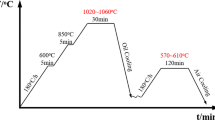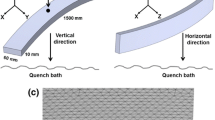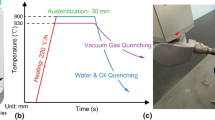Abstract
The stress and distortion that remain in steel products after quenching are harmful and undesirable. Therefore, a selected quenching medium should have a cooling rate equal to or greater than the critical cooling rate of the steel to achieve high hardness values, but the cooling rate should not be too large in order to minimize stress and distortion on the specimen. This paper studied the hardness, stress and distortion of C-ring samples quenched in 4% polyvinylpyrrolidone (PVP)-K60 solution and oil using simulated and experimental measurements. The results show that the maximum cooling rates (CRmax) of oil and 4% PVP-K60 quenchants are both higher than the critical cooling rate of steel. The CRmax of the 4% PVP-K60 solution is greater than that of the oil, and the cooling rate of the 4% PVP-K60 solution at 300 °C (CR300) is smaller than that of the oil. The greater the CR300 is, the greater the hardness, stress and distortion are. Thus, the hardness, stress and distortion values of the quenched sample depend less on CRmax and more on CR300. The research results also showed that a solution of 4% PVP-K60 could replace oil in the quenching of 100Cr6 steel. Simulated and experimental results of the hardness, stress and distortion of C-ring samples reflected the same rule. The errors between the simulation and experiment using the program and the computational conditions of distortion are approximately 20%. The numerical simulation method is entirely usable to predict the hardness, stress and distortion of a sample during the quenching process.






copyright 1972, with permission from Verlag Stahleisen












Similar content being viewed by others
References
C. E. Bates, G. E. Totten, and R. L. Brennan, Heat Treating of Steel, Vol. 4, ASM Handbook Committee, Section 1, (1991), 160 (1991)
Z. Li, B. L. Ferguson, X. Sun, and P. Bauerle, Proc. 23rd ASM Heat Treat. Soc. Conf., Pittsburgh, PA, USA (2005)
R.A. Hardin, and C. Beckermann, Proc. 59th SFSA Technical and Operating Conference, Chicago, Paper No. 3.3, Steel Founders' Society of America, (2005)
N. Cyril, B. Cyrille, L. Stéphane, T. Mihaela, and B. Régis, Comparison of Experimental and Simulation Distortions of Quenched C-ring Test Parts, Int. J. Mater Form, 2009, 2, p 263. https://doi.org/10.1007/s12289-09-0484-y
G. E. Totten, C. E. Bates, and N. A. Clinton, Handbook of Quenchants and Quenching Technology, ASM International, Materials Park, 35 (1993)
T.X. Tran, X.P. Nguyen, D.N. Nguyen, D.T. Vu, M.Q. Chau, O.I. Khalaf, and A.T. Hoang, Effect of Poly-Alkylene-Glycol Quenchant on the Distortion, Hardness, and Microstructure of 65Mn Steel, Comput. Mater. Continua, 2021 https://doi.org/10.32604/cmc.2021.01541
G. E. Totten Polymer Quenchants for Induction Heat Treating Applications: The basic, Union Cacbit Corporation 771 Old SawMill River Road Tarrytown, NY 10591, (2000)
M. Eshraghi-Kakhki, M.A. Golozar, and A. Kermanpur, Application of Polymeric Quenchant in Heat Treatment of Crack-Sensitive Steel Mechanical Parts: Modeling and Experiments, Mater. Des., 2011 https://doi.org/10.1016/j.matdes.2010.12.023
Z. Koudil, R. Ikkene, and M. Mouzali, Cooling Capacity Optimization: Calculation of HardeningPower of Aqueous Solution Based on Poly(N-Vinyl-2-Pyrrolidone), J. Mater. Eng. Perform., 2014 https://doi.org/10.1007/s11665-013-0775-9
M. Julinová, J. Kupec, J. Houser, R. Slavík, H. Marusincová, L. Cervenáková and S. Klívar, Removal of Polyvinylpyrrolidone from Wastewater Using Different Methods, Water Environ. Res., 2012 https://doi.org/10.2175/106143012X13373575830999
E. Vieira, L.V. Biehl, J.L.B. Medeiros, V.M. Costa and R.J. Macedo, Evaluation of the Characteristics of an AISI 1045 Steel Quenched in Diferent Concentration of Polymer Solutions of Polyvinylpyrrolidone, Sci. Rep., 2021 https://doi.org/10.1038/s41598-020-79060-0
A.A. Zainulabdeen, N.Y. Mahmood and J.H. Mohmmed, The Effect of Polymeric Quenching Media on Mechanical Properties of Medium Carbon Steel, Mater. Sci. Eng., 2018 https://doi.org/10.1088/1757-899X/454/1/012053
B. Hernandez-Morales, O. Barba-Mendez, A. Ingalls-Cruz and J.A. Barrera-Godinez, Mathematical Modelling of Temperature and Stress Evolution During Cooling of a Stainless Steel Navy C-ring Probe, Int. J. Mater. Prod. Techn ol., 2005 https://doi.org/10.1504/IJMPT.2005.007957
N. Chen, L. Han, W. Zhang and X. Hao, Enhancing Mechanical Properties and Avoiding Cracks by Simulation of Quenching Connecting Rods, Mater. Lett., 2006 https://doi.org/10.1016/j.matlet.2006.10.078
K. Clemons, C. Lorraine, G. Salgado, A. Taylor, J. Ogren, P. Umin and O.S. Es-Said, Effects of Heat Treatments on Steels for Bearing Applications, JMEPEG, 2007 https://doi.org/10.1007/s11665-007-9075-6
L. Rogal, G. Korpala and J. Dutkiewicz, Evolution of Microstructure in 100CR6 Steel after Cooling from A Thixoforming Temperature to Bainitic Transformation Ranges, Mater. Sci. Eng., A, 2014 https://doi.org/10.1016/j.msea.2014.11.055
H.Webster and W. J. Laird, Martempering of steel, Vol. 4, ASM Handbook Committee 137. (1991)
C. Nan, D.O. Northwood, R.J. Bowers and X. Sun, Study on the Dimensional Changes and Residual Stresses in Carbonitrided and Ferritic Nitrocarburized SAE 1010 Plain Carbon Steel, Mater. Sci. Forum, 2010 https://doi.org/10.4028/www.scientific.net/MSF.638-642.829
V. Campagna, R. Bowers and D.O. Northwood, Distortion and Residual Stresses in Nitrocarburized and Carbonitrided SAE 1010 Plain Carbon Steel, SAE Int. J. Mater. Manuf., 2008 https://doi.org/10.4271/2008-01-1421
ESI Groups Sysweld 2017.0 Materials Database - CD Toolbox. 99 Rue Des, Solets Silic 112 94513 Rungis Cedex France, (2017)
G.U.O. Jiang, F.U. Haiyang, P.A.N. Bo and K.A.N.G. Renke, Recent Progress of Residual Stress Measurement Methods: A Review, Chin. J. Aeronaut., 2019 https://doi.org/10.1016/j.cja.2019.10.010
O.C. Zienkiewicz, The Finite Element Method McGraw-Hill, London, (1977)
K.J. Bathe, Finite Element Procedures in Engineering Analysis, Prentice-Hall, Englewood Cliffs, 1982.
M.E. Fitzpatrick, A.T. Fry, P. Holdway, F.A. Kandil, J. Shackleton and L. Suominen, Determination of residual stresses by x-ray diffraction - Issue 2, Measurement Good Practice Guide No. 52, ISSN 1744-3911, The Controller of HMSO and the Queen's Printer for Scotland, (2005).
E. Mueller, Precision of the Residual Stress determined by X-ray Diffraction: Summery and Limits, 19th International Congress of Metrology, (2019) https://doi.org/10.1051/metrology/201927001.
K. Bobz, W. Wietheger, M.A. Knoch, A. Schacht, U. Reisgen, R. Sharma and L. Oster, Comparison of Residual Stress Measurements Conducted by X-ray Stress Analysis and Incremental Hole Drilling Method, J. Therm. Spray Tech., 2020 https://doi.org/10.1007/s11666-020-01056-z
P.S. Prevéy, X-ray Diffraction Residual Stress Techniques, Metals Handbook. 10. Metals Park: American Society for Metals, 380 (1986)
M.M. Nunesa, E.M. da Silvab, R.A. Renzettia and T.G. Britoa, Analysis of Quenching Parameters in AISI 4340 Steel by Using Design of Experiments, Mater. Res., 2019 https://doi.org/10.1590/1980-5373-MR-2018-0315
A.D. da Silva, T.A. Pedrosa, J.L. Gonzalez-Mendez, X. Jiang, P.R. Cetlin and T. Altan, Distortion in Quenching an AISI 4140 C-ring – Predictions and Experiments, Mater. Des., 2012 https://doi.org/10.1016/j.matdes.2012.05.031
M. Manivannan, D.O. Northwood and V. Stoilov, Use of Navy C-rings to Study and Predict Distortion in Heat Treated Components: Experimental Measurements and Computer Modelling, Int. Heat Treat. Surf. Eng., 2014 https://doi.org/10.1179/1749514814Z.000000000119
E. Troell, H. Kristoffersen, S. Segerberg, Thermal Engineering of Steel Alloy Systems, Comprehensive Materials Processing, 99 (2014)
J.K.Brimacombe, S.M. Gupta, and E.B. Hawbolt, Determination of Quench Heat-Transfer Coefficients Using Inverse Methods, in Proceedings from the First 74 International Conference on Quenching and Control of Distortion, Chicago, Illinois, (1992)
Mills, A.F, Heat Transfer. 2nd Ed ed., “Upper Saddle River”, NJ: Prentice Hall, (1999)
J.P. Holman, Heat Transfer, McGraw-Hill Inc, Florida, 2004.
F. Kreith, Mechanical Engineering Handbook, CRC Press LLC, Florida, 1999.
G.E. Totten, Steel Heat Treatment: Metallurgy and Technologies, 2nd ed. CRC Press, Boca Raton, 2006.
C. Civera, B. Rivolta, R.L. Simencio-Otero, J.G. Lúcio, G.E. Totten and L.C. Canale, Vegetable Oils as Quenchants for Steels: Residual Stresses and Dimensional Changes, Mater. Perform. Charact., 2014 https://doi.org/10.1520/MPC20140039
Y.Y. Feng, C. Xu, X. Su, Y.L. Sun, X. Pan, Y.D. Cao et al., Inflence of Austenization Temperature on Microstructure and Mechanical Properties of a New Ultra-high Strength Low Alloyed Steel, Mater. Test., 2017 https://doi.org/10.3139/120.111103
Acknowledgments
This research is funded by Hanoi University of Science and Technology (HUST) under project number “T2021-PC-030.”
Author information
Authors and Affiliations
Corresponding author
Additional information
Publisher's Note
Springer Nature remains neutral with regard to jurisdictional claims in published maps and institutional affiliations.
Rights and permissions
About this article
Cite this article
Tran, X.T., Pham, A.H., Van Hoang, V. et al. Stress and Distortion of 100Cr6 Steel after Quenching in Aqueous 4% Polyvinylpyrrolidone Solution. J. of Materi Eng and Perform 31, 6672–6688 (2022). https://doi.org/10.1007/s11665-022-06726-3
Received:
Revised:
Accepted:
Published:
Issue Date:
DOI: https://doi.org/10.1007/s11665-022-06726-3




